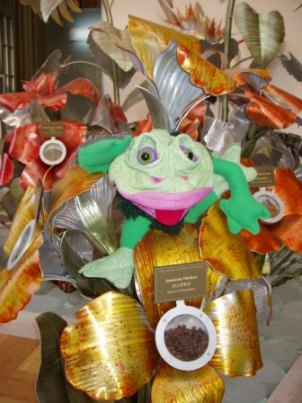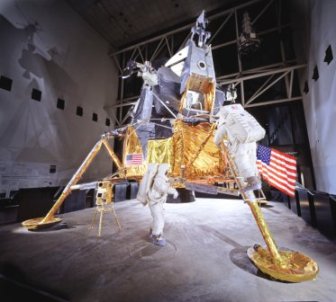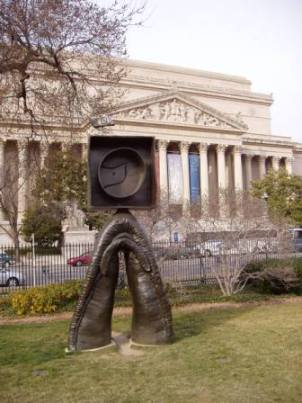 Family Travel Files Ezine Family Vacations Resource Family Travel Files Ezine Family Vacations Resource |
Washington DC Family Vacations with Rockets, Dinosaurs, and a Panda. DC offers enough museums, theaters, events, and activities to fill a book. From sniffing scents at the U.S. Botanic Garden or counting bugs at The National Museum of Natural History to riding the carousel on the Mall or taking the Metro to the National Zoo, the city is amazingly fun 24/7/365. Our action list focuses on the best places to enjoy science and nature including the best options for families.
Here's the scoop. Washington DC can be overwhelming for families on a holiday. There are enough places and activities to fill several vacations so it is best to get a plan – a short list. In every case it is best to do less and have more fun as a result. Our notations have been divided so that off the Mall gets equal coverage and Alexandria stands by itself. In any season Washington offers families plenty to do, obviously during the summer season the lines will be longer and the weather warmer. Our action list focuses on the best places to enjoy science and nature including the best options for families with school age children.
Take time to smell the flowers. The science of plants and flowers can be fun with kids and steps from the Capitol, the U.S. Botanic Garden (USBG) with its dramatically beautiful Conservatory proves it. In any season this is worth a look but when the orchids are in bloom in the main gallery it is an amazing place – a major WOW! Divided into climatic galleries some inside and some outside it is an easy place to browse with kids. Throughout the year there are timely exhibits always with an interactive component which supports the theme and often solidifies the experience. Bonus Points: Best of all is the gallery of aromas created to engage and enchant all ages. Larger than life flower sculptures create an imaginary worlds where each offers it own signature scent. There is even a mixing table where scents may be mixed and matched. Spending time in this delightful room is a blast with kids of any age, even teens who often are fascinated by what makes a scent work. If you have allergies check the blooming schedule. (245 First Street, S.W., Washington, DC, 20024. (202)225-7099 or www.usbg.gov)
Discover bugs, diamonds and dinosaurs. The National Museum of Natural History is home to the famous Hope Diamond, an assortment of dinosaurs, old bones, funky minerals, assorted botanicals, and bugs, really cool bugs. Mobile docent managed Discover Stations are generally available in selected exhibits on Tuesdays through Fridays making it easy to engage kids in a variety of ways. Activities focus on concepts and topics presented in nearby exhibits and take about five minutes to complete. Now through January 2013, visitors to the museums can check out the The Evolving Universe - a mind-bending journey with from present-day Earth to the far reaches of space and the distant past—back to the beginning of the universe. Explore how stars and galaxies—even the universe itself—change from birth to maturity to death, much like living things on Earth. Bonus Points: Bug Corner is not to be missed. Within the space docents allow visitors to hold an insect, participate in a tarantula feeding, and get answers to questions. Throughout the year there are many unique family programs. The details are posted at the website. (10th Street and Constitution Avenue NW. DC. (202) 357-2700 or www.mnh.si.edu) See the pandas. Seen on t-shirts, postcards, stickers and even the DC Metrocards the city’s unofficial mascots, giant pandas Tian Tian, Mei Xiang and their cub Tai Shan live at the National Zoo. Part of the Smithsonian Institution, is an exotic 63-acre zoological park with more than 2,400 animals of 400 species. The Zoo has added a number of new additions—recent births include a mountain gorilla and a Sumatran tiger. Daily programs include animal training, feeding demonstrations, and keeper talks. Some programs change from week to week. From cheetah chats and elephant baths to eagle feeding and reptile encounters, there is always something really cool going on. Bonus Points: Kids' Farm is one of the newest exhibits at the Zoo. While kids enjoy hands-on features and animal contact areas, they will also learn just how much of the food we eat everyday comes from farms. The demonstration example is a 22 ft-wide pizza which shows the multiple origins of our food. Throughout the summer months there are free evening concerts. (National Zoological Park 3001 Connecticut Avenue, NW, DC. (202) 633-4800 or nationalzoo.si.edu)
Look into space.  The National Air and Space Museum has plenty of action. This facility very popular so to lessen the stress arrive early and have a plan. If you’ve ever looked to the stars or dreamed of flying among them, then this is the place to go. The museum’s exhibits cover the span of the history of aviation, from man’s first attempts at flight to modern space probes, and World War II rockets. Other galleries highlight the politics, physics and art linked to man’s dreams of reaching for the stars – one highlight is the Skylab model, a life-size replica of the actual Skylab used in space. See the Wright 1903 Flyer; the Spirit of St. Louis; the Apollo 11 command module Columbia; and a Lunar rock sample that visitors can touch. The Albert Einstein Planetarium, located within the museum itself, offers visitors a truly cosmic experience, and the Langley Theater features stunning IMAX films on air and space travel. Bonus Points: Throughout the museum there are many free 5-15 minute interactive experiences. Perhaps the most popular spot for young children is the “How Things Fly” gallery because it is loaded with hands-on activities, docent science demonstrations; paper airplane contests; and 50 interactive devices. Throughout the year there are free “Family Days” as well as lectures and public programs. (The National Air and Space Museum Sixth Street and Independence Avenue SW (202) 357-2700 or www.nasm.si.edu)
See your own DNA. The 6,000 square-foot Marian Koshland Science Museum is located in Washington, DC’s historic Penn Quarter neighborhood just three blocks north of the National Mall. National Academy of Sciences brings practical science to life by using unique, interactive exhibits to support current thinking of scientists about things like DNA, global warming and the universe. Hands-on science demonstrations are conducted at the museum every weekend and on selected holidays from March through October. The demos are led by student trainees from DC area high schools. Bonus points: One of the coolest hands-on science demonstrations allows a visitor the chance to extract DNA from his/her own cheek cells and take it home in a necklace vial. (The Marian Koshland Science Museum and The National Academies 500 Fifth Street, NW Washington, DC 20001. (202)334-1201, toll-free 1-888-KOSHLAND (888-567-4526) or www.koshlandscience.org)
See the fishes. This is on DC’s secret list of great places for families. Only one block from the Washington Monument, the National Aquarium is located in the Department of Commerce Building is an easy space to navigate with tykes. Not the grand scale of Sea World, the National Aquarium is a quieting place with oodles of brightly colored marine life to be enjoyed. A comfortable cruise through the facility will take about and hour unless you and your kids become distracted by the clown fish or iridescent looking sea urchins. Bonus Points: Animal keeper talks and animal feedings occur every day. And throughout the year there are oodles of special family events. Need to know: Credit cards cannot be accepted for admission so plan to pay by cash or check. (The National Aquarium in Washington, D.C. Commerce Building, Room B-077 14th & Constitution Avenue, NW Washington, DC 20230. (202) 482-2826 or www.nationalaquarium.com) Touch the world.  This fascinating museum has great appeal to all age groups. Most memorable perhaps is the 11-foot globe in the main hallway. It is the largest of its kind in the world. Beyond the large planet sculpture, the facility showcases exciting in-person reports from the frontiers of adventure; behind the lens with the world's best photographers; screenings of productions from the National Geographic All Roads Film Project, National Geographic Channel, National Geographic Television, and independent filmmakers. Here's the dea! Admission to Tuesdays at noon is free—no tickets required. And the online museum provides links for children. Categories include Games and Interactive Activities; Homework/Project Resources and for parents an online education guide. Bonus Points: Throughout the year there are interesting programs for families. Upcoming events include a day of award winning animated films; geomania –all about maps; an inspiring blend of folk and pop peppered with reggae, Latin, blues, jazz, and classical music presented by Trout Fishing in America and Rock Creek Park BioBlitz in May. These are the guys who publish National Geographic Kids Magazine (National Geographic Explorers Hall, 1600 M Street, NW Washington, D.C. 20036. (202) 857-7700, 857-7588 or www.nationalgeographic.com/explorer) Ride the Metro. For many kids riding the Metro will be an event all by itself and Washington, DC's Metrorail system is safe, clean, user friendly and efficient. Daily passes are available for transit after 9:30 a.m. and offer unlimited riding for $9. Get the details at www.metroopensdoors.com
Information researched and posted by Nancy Nelson-Duac, curator of the Good Stuff for the Family Travel Files. Images provided by Family Travel Files staff. Copyright updated 2017.
|